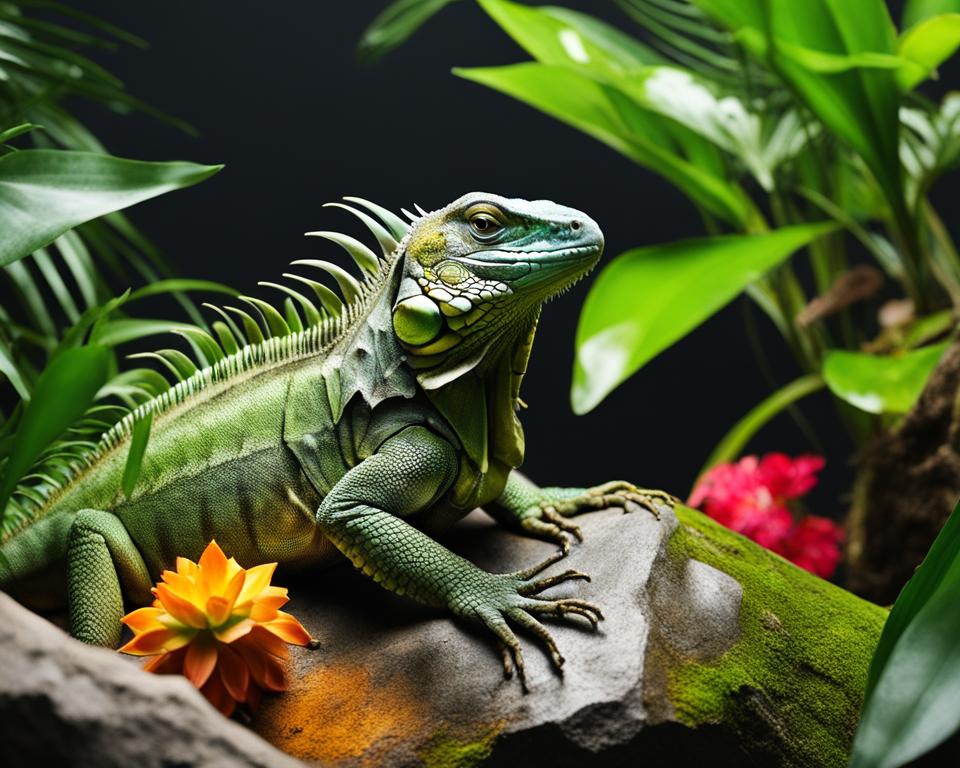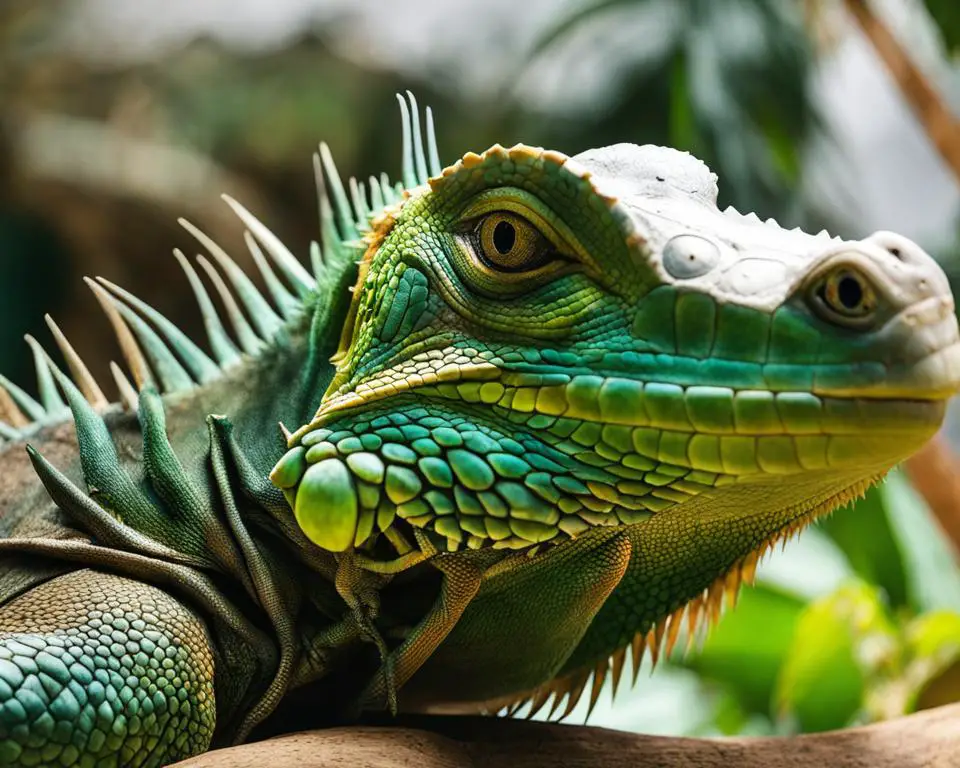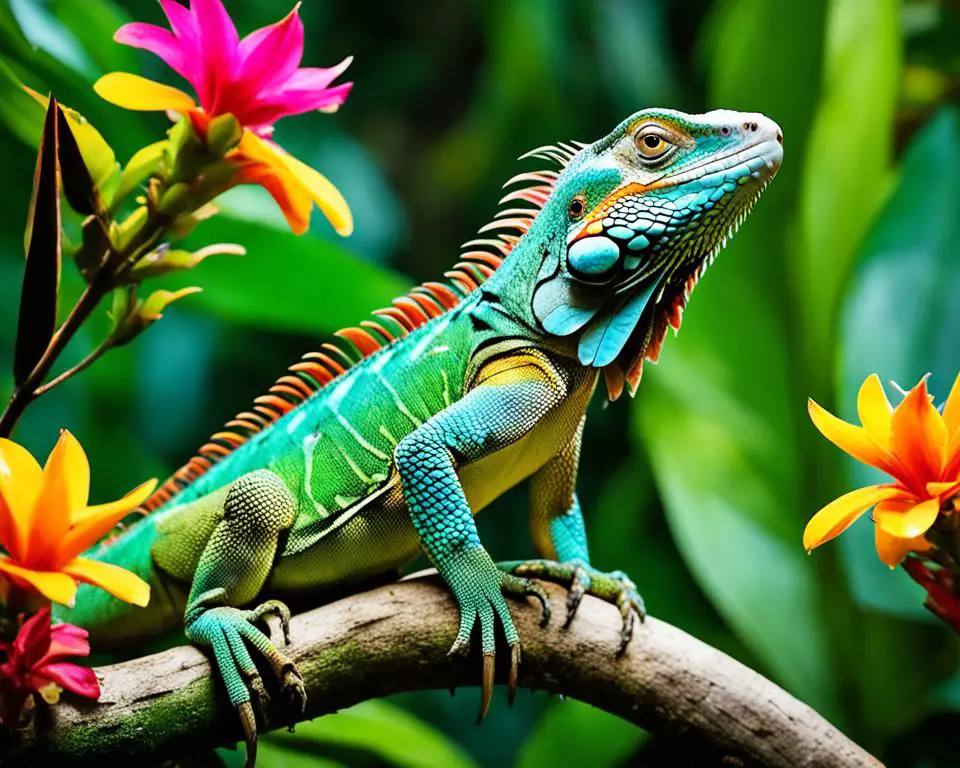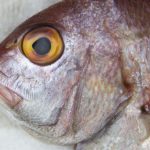Prepare to marvel at the intricate tapestry of iguana facts that showcase these vibrant creatures in a fresh light. The Green Iguana, with its lush, jade-hued scales, has made an impression on reptile enthusiasts and novices alike. Stepping into their dynamic realm, you’ll encounter a rich blend of wildlife marvels and in-depth reptile insights that bring the essence of the iguana habitat right to your fingertips.
Whether you’re a seasoned pet iguana owner or you’re considering joining the ranks, understanding the unique desires and behaviors of these exotic animals is fundamental. Let’s embark on a scintillating journey through their world, exploring the pockets of their existence from the lush jungles of Central America to the verdant backyards of unexpected geographies.
Discovering Iguanas: Journey from the Tropics to Your Backyard
The story of green iguanas in Florida is as colorful as their scaly hides. An intriguing chapter of urban wildlife, these reptiles of Central and South American origin have made the Sunshine State their own, beginning in the 1960s. The resultant iguana population boom has turned them into both captivating neighborhood fixtures and nuisance wildlife.
Tracing their lineage back to the tropics, these creatures have adapted to the Floridian landscapes with remarkable ease. Their presence is a testament to the reptile’s ability to survive and even thrive outside of their natural habitat—a stark example of reptile adaptation. Yet, while many Floridians have embraced iguanas as pets, others regard the burgeoning numbers of wild iguanas in Florida with concern over environmental impacts and property damage.
- From Curiosity to Concern: Iguanas add exotic charm to the backdrop of Florida’s fauna, yet they pose significant challenges for homeowners and ecologists.
- Reptile Adaptability: Florida’s warm climate favorably compares to the iguana’s native tropical environments, promoting a spike in their survival rates.
- Unintended Residents: Iguanas may have started as exotic pets, but now roam wild across Florida’s urban and suburban areas.
These inveterate sun-seekers bring forth a blending of awe and inconvenience as they navigate through our collective backyard. To grasp the scope of the situation, consider the numbers:
| Decade | Estimated Population Growth | Impact on Native Ecosystems |
|---|---|---|
| 1960s | Initial Introduction | Minimal Recognition |
| 1990s | Rapid Increase | Rising Concerns |
| 2020s | Widespread Prevalence | Active Management Efforts |
As we look to the future, it’s crucial for residents and wildlife managers alike to balance the novelty of iguanas’ presence with the practicality of coexistence and sustainability.
Why Florida’s Climate is Perfect for Iguanas
If you’re fascinated by the vibrant wildlife of the Sunshine State, you’ve likely noticed that iguanas are becoming as synonymous with Florida as palm trees and beaches. This isn’t just a coincidence; the environmental temperature and abundant sunshine in Florida provide an ideal setting for these reptiles. Let’s explore what makes Florida, especially areas like Miami and the Florida Keys, a dream come true for these cold-blooded creatures.
Thriving in Warm Environments
Native to hotter climes, iguanas rely on external heat to regulate their body temperature. The Florida climate emulates the tropical conditions of Central and South American reptile habitats, where these iguanas originate. With the rise in both environmental temperature and urban development, iguanas in Miami find numerous sun-filled spots to lounge and maintain their bodily functions.
Sunning in South Florida: A Reptile’s Dream
Delve deeper into South Florida, and you’ll see that it’s not just the warmth but the quality of sunlight that draws iguanas. These Florida Keys wildlife members bask in direct sunlight, which is crucial not only for their survival but also for their wellbeing. The extended daylight hours in places like the Florida Keys ensure iguanas can thrive all year round.
- A proclivity for warm weather makes cities like Miami and the Florida Keys prime real estate for iguanas.
- Direct sunlight aids in the physiological processes necessary for iguana health, promoting an environment where they can flourish.
As your scaly neighbors soak up the rays, remember that while they may cause issues for residents at times, iguanas also add to the unique tapestry of Florida’s vibrant ecosystem.
The Surprising Aquatic Skills of Iguanas
Upon observing the green iguana, a symbol of reptile agility in its terrestrial environment, one might not immediately consider them adept swimmers. Yet, these creatures possess remarkable aquatic skills that are a testament to their adaptability in varied habitats. Such iguana adaptations support their survival both as marine reptiles and freshwater swimmers, giving them a notable place among nature’s versatile inhabitants.
Natural Swimmers: Saltwater and Freshwater Adaptations
When you look beyond the iguana’s dominant presence on land, you’ll discover their equally impressive capacity to navigate waters. Green iguanas are not just occasional paddlers; they are sophisticated swimmers who have mastered the subtleties of movement in both saltwater and freshwater ecosystems. The structural design of their bodies, complete with powerful tails, contributes to the effortless slices through water, marking them as adept in aquatic locomotion.
Impressive Breath-Holding Capabilities
Their ability to control breath extends their adaptability. Green iguanas can immerse themselves in the watery depths with breath control that rivals the best of marine wildlife. Their lungs, attuned to their environment’s demands, allow them to hold their breath for up to 15 minutes. This skill is particularly beneficial for evading predators, foraging underwater, or simply enjoying the aquatic experience. It’s a dazzling display of reptilian prowess that underlines the iguana’s survival strategy and agility within its habitat.
Iguanas’ Lifespan: A Committed Pet for Life
When you consider welcoming pet iguanas into your home, keep in mind their impressive green iguana lifespan. In the wild, iguanas usually have a life expectancy of about 9 years; however, with responsible captivity care, these exotic pets can share up to 20 years with their human companions. The journey with a pet iguana is not for the faint of heart—it’s a long-term commitment that requires understanding, patience, and dedication.
Providing optimal conditions is key to promoting reptile longevity. A substantial part of iguana care hinges on replicating their natural environment as closely as possible within your home. The proper habitat, diet, and preventative medical care are the pillars of extending a green iguana’s lifespan while ensuring their health and vitality. Below is a comparison of major care factors and how they affect green iguana longevity in captivity as opposed to the wild:
| Care Factor | Impact in the Wild | Impact in Captivity |
|---|---|---|
| Habitat | Exposed to predators and elements | Protected, controlled environment |
| Diet | Variable, dependent on availability | Optimized for nutritional balance |
| Medical Care | Limited to none | Regular veterinary checkups |
| Stress Factors | Competition, climate fluctuations | Minimized with proper care |

While owning an iguana can be richly rewarding, it’s essential to acknowledge the time and resources necessary to support their prolonged lifespan. If you’re ready to undertake the gratifying challenge of iguana ownership, you’ll be investing in a bond that can span decades. Just as you grow and evolve, so will your pet iguana, becoming a treasured member of your family through every stage of life.
Tail Shedding and Regeneration: Iguana’s Defense Mechanism
Unbeknownst to many, the Green Iguana is equipped with a remarkable survival tactic known as tail autotomy. This biological feature is paramount in the realm of iguana survival tactics, ensuring their legacy in challenging ecosystems. This process, along with regular skin regeneration and relocation, underscores the vigor and adaptability that define these reptiles.
Surviving Predators: The Science Behind Tail Release
When confronting a predator, iguanas utilize tail autotomy as an escape mechanism. This self-defense behavior involves detaching their tail at specific fracture points, creating a life-saving distraction. After the tail is sacrificed, it continues to twitch, diverting the predator’s attention and allowing the iguana a critical opportunity to flee. This phenomenon, which can be the difference between life and death, highlights the fascinating aspects of iguana survival tactics.
Shedding Skin for Growth and Health
Alongside tail shedding, iguanas experience regular skin shedding or reptile molt. This allows for growth and the removal of parasites and damaged skin. Young iguanas, in particular, shed more frequently as part of their rapid reptile growth phase. As they mature, the rate of shedding decreases; yet, it remains a critical aspect of their overall health, demonstrating their ability to continually regenerate skin and adapt to their growing bodies.
- Tail autotomy enables iguanas to evade capture and survive encounters with predators.
- Skin regeneration and reptile molt are essential for accommodating growth and maintaining skin health.
- Young iguanas may regrow their tails, showcasing the impressive regenerative capabilities of these reptiles.
The Mystery of the Third Eye: Iguanas’ Sensory Capabilities
The unique anatomy of iguanas extends beyond their scaly skin and agile movements. Nestled atop their verdant crowns sits an extraordinary sensory organ known as the parietal eye. This vestigial structure may seem the stuff of science fiction, yet it holds a pivotal role in the daily survival of these reptiles. The iguana pineal gland, similar in structure to the parietal eye, is a prime example of evolutionary ingenuity, equipping iguanas with an internal radar for predator detection and environmental awareness.
Understanding the Parietal Eye
At first glance, the parietal eye might be mistaken for a mere scale, but its function is far more complex. Unlike the main eyes that offer sharp, colorful reptilian vision, the parietal eye primarily senses changes in light intensity. This is particularly useful during basking, as it helps regulate exposure to sunlight, thus playing a crucial role in thermoregulation and the reptile’s circadian rhythms.
What Movement and Light Mean to Iguanas
For iguanas, movement and light are signals in their vast sensory network. The parietal eye doesn’t resolve images the way their lateral eyes do, but it is sensitive enough to notice the swift shadow of an overhead predator, triggering an instinctive defensive response. This additional eye strengthens the iguana’s sensory organs, sharpening their awareness and ensuring their status as resilient survivors in diverse ecosystems.
- Light detection aids in absorbing vital UV rays for health and well-being.
- Movement sensing is essential for quick reactions to aerial threats or changes in the environment.
- The parietal eye serves as an evolutionary tool for overall survival and sensory adaptation.
As you explore the world of iguanas, take a moment to appreciate the silent, watchful vigil kept by the parietal eye, an evolutionary masterpiece nestled in the unassuming peak of these remarkable reptiles’ heads.
Understanding Iguana Communication: More Than Just Body Language
As a reptile enthusiast or a potential iguana pet owner, it’s essential to understand the sophisticated ways these creatures communicate with one another. Unlike humans, who predominantly use verbal language, iguanas rely heavily on a series of distinctive Iguana nonverbal cues to convey messages to their peers. Recognizing and interpreting these signals provides a fascinating glimpse into the complex world of Reptile communication.
One of the most easily recognized behaviors is Head bobbing, a form of expression among iguanas that varies in meaning based on the speed and context of the movement. A slow nod can signify a friendly acknowledgment, while rapid bobbing may indicate a stern warning or a display of dominance. On observing these creatures in their natural surroundings or even in captivity, you might notice the variety of head bobs and what they signify in the social structure of iguanas.
An equally significant aspect of iguana interaction is their use of Dewlap gestures. The dewlap is a flap of skin under the iguana’s neck which they can extend outwards. Interestingly, this action serves multiple purposes such as regulation of body temperature, but in terms of communication, a displayed dewlap can be an act of intimidation in Territorial displays, a friendly greeting, or part of a mating ritual.
Understanding these signals enriches your ability to foster a healthy and stress-free environment for these reptiles. Whether you’re an iguana owner or a curious observer, paying attention to these nonverbal cues is not only captivating but also enables a deeper connection with these magnificent creatures.
- Slow head bobbing: typically a sign of recognition among iguanas or a peaceful greeting.
- Rapid head bobbing: often a display of aggression, perhaps during territorial disputes.
- Extended dewlap: can be seen in both courtship to attract mates and as a show of dominance.
Subtle yet powerful, these forms of Reptile communication form the tapestry of iguana society and influence their interactions. Next time you encounter these fascinating reptiles, consider their behavioural language, and you’ll gain a deeper appreciation for their complex social dynamics.
Unusual Weather Phenomena: Iguanas Falling From Trees
Have you ever heard about iguanas raining down from the skies in Florida? While it may sound like a folktale, this meteorological oddity has its roots in the unique biological response of the cold-stunned iguanas to the Sunshine State’s occasional cold snaps. Witnessing these reptiles falling from their perches illustrates a startling intersection between Florida weather impact and the reptile metabolism.
How Cold Stuns Iguanas Into a Comatose State
When temperatures plummet in Florida, the cold-blooded iguanas experience a dramatic slowdown in their metabolism. This metabolic deceleration leaves the cold-stunned iguanas in a comatose state, too slow and stiff to cling to their arboreal havens. What follows is a surprising tumble to the ground, a sight that might alarm the uninitiated Floridian or visitor. But don’t be deceived – these iguanas are very much alive, merely paused by the chill, and will rouse again with the return of warmer air.
Adapting to Colder Climates: A Potential Threat to Florida Ecosystems
As much as this phenomenon may seem temporary, it heralds a more pressing issue. The iguanas’ increasingly apparent ability to survive and potentially adapt to colder climates raises alarms about invasive species concerns. If these reptiles, already notorious for their impact on local flora and fauna, begin to establish themselves in regions previously too chilly, the repercussions for Florida ecosystems could be significant. It compels conservationists and residents to consider long-term strategies for climate adaptation and nuisance wildlife management.
These cold-weather episodes cue a fascinating but formidable reminder of the resilience and complexity of Florida’s wildlife as it adapts alongside shifting climatic rhythms. For the Floridian, it is an uncanny spectacle and a stark note of the relationship between environment and survival – one that continues to evolve with each drop in temperature.
Dealing With Iguanas in Florida: Beyond the Fascination
While the sight of iguanas in Florida can be charming and adds an exotic flair to the local wildlife, these reptiles can cross the line from intriguing creatures to troublesome pests. The growing concern for property damage prevention and conservation issues has seen a rise in the need for effective nuisance wildlife management. Understanding and implementing humane methods of iguana control are essential for maintaining balance within the ecosystem and safeguarding your property.
Green Iguanas: From Pets to Pests
Initially invited into homes as captivating pets, green iguanas have now proliferated across Florida, leading to a myriad of ecological challenges. These reptiles, while not protected by law, can cause significant damages to infrastructure and the environment, transforming them into unwelcome guests in many communities. Emphasizing iguana removal is vital not only for the safety of residential areas but also for the protection of native flora and fauna.
Humane Methods of Iguana Control
Devising effective strategies for managing the iguana population is crucial. Floridians are tasked with addressing this problem by employing compassionate and ecologically responsible methods. Approaches range from habitat modification to prevent iguana encroachment to professional removal services that ensure the iguanas are handled ethically. Everyone plays a role in conservation issues, contributing to a sustainable solution that respects the wildlife while safeguarding our homes.
As we delve deeper into this situation, here are the key aspects of humane iguana control currently employed in Florida:
- Environment alteration: Restructuring landscaping to deter iguana nesting and feeding.
- Protective barriers: Implementing fencing and other safeguards to prevent iguanas from entering specific areas.
- Professional removal services: Engaging certified wildlife experts to humanely capture and relocate iguanas.
If you’ve encountered an iguana on your property, remember that while they are a natural part of Florida’s diverse ecosystem, it’s important to handle them properly to prevent harm to both the animals and the environment.
Iguana Housing: Size and Comfort Matters
When you choose to take on the responsibility of iguana ownership, understanding the habitat requirements is non-negotiable. These majestic creatures need more than just a tank; they require reptile enclosures that align with their natural inclinations for space and comfort. A happy iguana is one that has room to roam, climb, and explore within its own private domain.
It’s crucial to comprehend that the tank size directly influences your pet iguana care. Given the expansive growth these reptiles undergo, you might be surprised to learn the scale of enclosure they necessitate. Bigger really is better when it comes to iguana habitats, with the need for spacious areas where they can indulge in their instinctual behaviors.
Fulfilling these habitat needs is a core element of ethical pet iguana care. Provided below is a detailed table showcasing the essential dimensions and features required for an effective iguana enclosure:
| Feature | Description | Minimum Requirement |
|---|---|---|
| Enclosure Size | Overall space to accommodate growth and movement. | At least twice as long as the iguana, minimum six feet in height. |
| Climbing Spaces | Vertical features allowing for natural climbing behavior. | Multiple sturdy branches and shelves to support the iguana’s weight. |
| Temperature Variation | Range of temperature zones within the enclosure for thermoregulation. | A basking area at around 90°F and a cooler zone not falling below the mid-70s. |
| Humidity Control | The moisture level which impacts hydration and skin shedding. | 60-70% humidity, adjustable through misting and water features. |
| UV Light Availability | Exposure to UV light for physiological processes. | UV bulbs replaced bi-annually to prevent metabolic bone disease. |

Remember, creating the optimal environment for your iguana goes beyond the basics of food and water. It’s about recreating a slice of their native habitat that acknowledges their climbing spaces and affords them the liberty to live as they would in the wild. By respecting these guidelines, not only do you ensure the health and longevity of your iguana, but you also enrich the bond shared between pet and owner as you witness the full spectrum of their behaviors and personalities.
An enclosure that meets your iguana’s habitat requirements sets the stage for a healthful and interactive life for these exceptional reptiles. Investing in a proper home for your iguana signifies a commitment to their well-being and your dedication to providing them with the care they truly deserve. After all, a well-housed iguana is a content iguana, and their serenity will be reflected in their demeanor – offering you a source of endless fascination and companionship.
Heat and Light: Essential Elements for Iguana Health
Ensuring optimal reptile health for iguanas involves meticulously crafting a habitat that mirrors their natural tropical climate. Temperature and lighting are not mere environmental factors; they are crucial for iguanas’ physiological processes, including Vitamin D synthesis and the prevention of ailments such as metabolic bone disease.
The Right Temperature for Iguanid Well-being
Your iguana’s well-being hinges on the habitat’s thermal gradient, which should mimic the reptile’s natural environment. Achieving the perfect balance allows your iguana not only to survive but to thrive. The temperature gradient should span from a warm basking area to a cooler, shaded space—essential for regulating body temperature and facilitating normal behavior and digestion.
The Importance of UV Light in Preventing Metabolic Diseases
An iguana’s exposure to UV light is vital, having a direct impact on their capability to produce Vitamin D3, which is integral for calcium metabolism. This process is pivotal for bone health and the prevention of metabolic bone disease, a common yet grave condition that can afflict iguanas deprived of necessary UV exposure. Ensuring your iguana’s habitat includes a source of UVB light is non-negotiable for its longevity and quality of life.
When considering the fact that iguanas are naturally designed to bask in sunlight for a significant part of their day, the replication of this environment in captivity is essential. The UV light cannot pass through glass or plastic; therefore, direct exposure under a UV-emitting lamp is required for proper care.
- UVB lamps are crucial for Vitamin D synthesis, enabling calcium absorption and ensuring skeletal strength.
- Beyond bone health, UV exposure supports overall wellbeing and can influence mood and activity levels in iguanas.
- Replace UVB bulbs as recommended to maintain their efficacy, typically every six months.
By integrating these elements into your iguana’s habitat, you are proactively contributing to their health and happiness. Remember, an environment that keeps these majestic creatures at the right temperature and under appropriate lighting not only echoes their native conditions but ensures a robust, energetic, and healthy iguana.
The Vegetarian Giants: Analyzing the Iguana Diet
Exploring the nuances of iguana nutrition unearths a fascinating dietary profile tailored to the well-being of these herbivorous giants. Their natural preference for a herbivorous diet caters to their unique physiological requirements, promoting healthy feeding habits critical for longevity and vitality. To maintain the delicate balance of their internal systems, particularly kidney care, owners must pay close attention to the composition and variety of their meals.
Benefits of Leafy Greens and Vegetables
Leafy greens and vegetables form the cornerstone of iguana dietary needs, offering a rich mosaic of essential nutrients. This variety not only nurtures robust health but also aligns with the iguana’s natural consumption patterns observed in wild habitats. Regular inclusion of collard greens, mustard greens, and kale provides a spectrum of vitamins and minerals crucial for maintaining an iguana’s systemic harmony.
Minimizing Animal Protein for Kidney Health
While the occasional consumption of animal proteins may mimic opportunistic feeding in the wild, excessive reliance on such sources can place an undue burden on an iguana’s kidneys. Responsible pet owners must calibrate their iguanas’ diet with a predominance of plant-based sources, thus weaving the mainstay of a healthful and natural nutritional fabric that defends against potential renal complications.
As you delve deeper into the subtleties of iguana care, remember to chart a course that best replicates their innate dietary patterns:
| Food Group | Recommended Quantity | Benefits |
|---|---|---|
| Dark Leafy Greens | 50-60% | High in calcium and essential vitamins |
| Other Vegetables | 30-40% | Provides variety and additional nutrients |
| Fruits | 10% | Natural sugars and hydration |
| Animal Proteins | Occasional | Simulates varied diet; should be limited |
Embracing a diet plentiful in greenery not only bolsters an iguana’s health but also honors the ecological blueprint etched deeply within these creatures. A leafy banquet is more than a meal; it’s a gesture of respect toward the intricate biology that defines the iguana as a vital, thriving entity in the rich tapestry of life.
- Dark, leafy greens should be a staple for optimal calcium and vitamin intake.
- A diverse mix of vegetables enriches both the palette and the body.
- Fruits, while a smaller portion of the diet, offer sweetness and hydration.
- Limit animal proteins to safeguard kidney function and overall health.
Ultimately, your iguana’s diet sets the stage for a harmonious life—one where every meal nurtures the body and spirit of these revered vegetarian giants.
Conclusion
As we’ve explored the lush world of iguanas, these extraordinary reptiles have proven to be more than just exotic pet care subjects. They are complex beings with a storied history of longevity, distinct physiological traits, and nuanced behaviors. For those intrigued by the depth of the reptilian realm, iguanas present an enchanting opportunity. For you, the reptile enthusiast, iguana ownership is a pathway that leads not only to personal fulfillment but also to the broader horizon of eco-friendly pet choices.
Your journey with iguanas could be a symbol of commitment to conservation and wildlife, stretching beyond the confines of your terrarium to the ecosystems these creatures impact. Every aspect of iguana care reflects a balance between the domestic sphere and the natural world. As custodians of these vibrant beings, the responsibility you hold extends into the realm of safeguarding native habitats and species, echoing the ethos of preserving natural biodiversity.
In the intricate dance of life, iguanas have their unique steps, and now you are a part of it. By embarking on this fulfilling venture, remember that the rewards extend beyond the companionship of your scaly friend—they ripple out to the broader context of environmental sensitivity and stewardship. May your path with these splendid creatures be enlightening, as you embrace the challenges and interweave your passion for reptiles with tangible contributions to eco-friendly pet choices and wildlife conservation.











